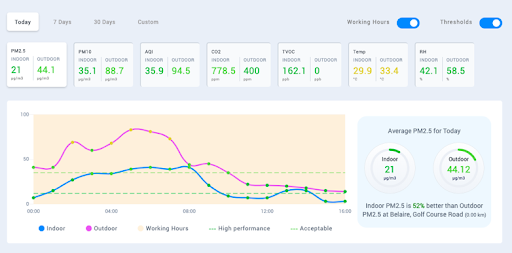Is your air purification system working?
We spend 90% of our time indoors. By ensuring clean air quality in schools, offices, hospitals and hotels, one can ensure good health for the occupants. There are various purification solutions available on the market, and one may pick a solution based on the limitations of their specific building, pollutants affecting their indoor air quality as well as cost considerations.
However, the only way to know if a particular solution is meeting the needs of the building, is to monitor the indoor air quality in the building and ensure that it consistently meets your air quality goals.
Indoor Air Quality StandardsTo validate performance of the system, it is important to have a clear set of goals that you wish to achieve for your building.
Most people are familiar with AQI or Air Quality Index. Air Quality Index is a standard for outdoor air quality and is defined for each country by its Govt. Airveda currently supports US AQI and Indian AQI but there are many other such AQI standards for different countries. Learn more about AQI here .
However air quality indoors is very different from outdoor air quality, as it is much easier to maintain better air quality indoors. In addition several pollutants like CO2 or TVOCs tend to be more of an indoor air quality problem rather than outdoor and are not included in AQI. AQI is hence, not a good metric to benchmark indoor air quality.
Until recently due to the lack of awareness around air quality, the standards around indoor air quality only took CO2 and ventilation into account. More recently with greater awareness about the harmful effects of air pollution, additional parameters like PM2.5, PM10, TVOCs are now being taken into account by several indoor air quality standards.
Airveda platform supports two indoor air quality standards which we believe are quite comprehensive:
Once you have chosen your standards, using the Airveda Platform you can track the daily, 7 days as well as 30 day average data to see if it meets the relevant standards.

You can also track the % of time you are meeting the necessary standards so that you can work on resolving leakage or other issues and slowly see your performance improve.
 Working hours
Working hours
When doing system validation it is very important to look at data specifically during working hours, because often systems are shut down during non-working hours. Also the data is most relevant during the working hours as that is when occupants are usually present in the building.
Comparison with OutdoorsIn places where air quality is really bad, often it is very hard to meet the indoor standard all the time. For such cases having a comparison with outdoors is essential as it allows you to see if the data is significantly better and your purification system is doing its job. RESET standard considers air quality within limits if the indoor air quality is 70% better than outdoors even if it doesn’t meet the standard when outdoor air quality is very poor. Airveda allows you to set up your own outdoor Air quality monitor or use data from the nearest Government monitor available.
 Comparison and Benchmarking
Comparison and Benchmarking
We see several clients install different solutions on different floors and then benchmark against each other to see which solution gives best performance. The AirVeda Platform allows users to compare performance for different rooms/floors enabling to see how various solutions are performing.
 Isolating problems in your building
Isolating problems in your building
Performance validation often involves going beyond just checking the purification system, to ensuring that leakage as well as local sources of pollutants like cleaning products or carpets are properly managed.
In some cases, one may implement the same solution on different floors but may find that the solution is more effective in one room or floor compared to others which may be indicative of leakage or other sources in that particular room/floor which need to be investigated.
Another situation we often see is that there are temporal sources of pollutants which are often hardest to identify. One interesting way to isolate such issues is to track daily trends. By looking at your hourly data for the day across long periods of time, you will often see trends like PM10 becoming high during cleaning cycles or PM2.5 becoming high during lunch times. Such data can help Isolate such temporal problems, enabling you to find specific solutions rather than changing or upgrading the entire solution unnecessarily.

Similarly weekly trends enable you to see if there are certain trends that are repeating on particular days of the week. For example you might find that every Monday PM levels are higher because there is more dust from the weekend and cleaning causes it to get suspended in the air or TVOC levels suddenly shooting up during weekly art sessions, or CO2 becoming very high during Friday weekly team meetings.

Above are some things to keep in mind when evaluating the performance of the air quality purification systems in your building as well as ensuring that your building is properly managing leakages as well as local sources of pollutants. If you wish to learn more about how Airveda can help you validate the performance of the purification system installed in your building please contact us at info@airveda.com.
Do leave your thoughts and comments below. We look forward to hearing from you.

